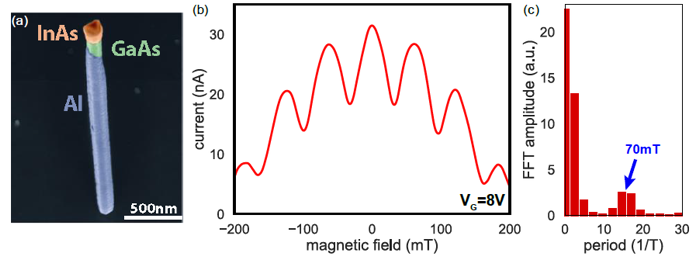Flux-periodic supercurrent oscillations in GaAs/InAs/Al core/shell/halfshell nanowire Josephson junctions
P. Zellekens1, R. Deacon1,2, M. Randall1,2, P. Perla3,4, A. Pawlis3,4, D. Grützmacher3,4, T. Schäpers3,4, K. Ishibashi1,2
1 RIKEN Center for Emergent Matter Science, 351-0198 Saitama, Japan
2 Advanced Device Laboratory, RIKEN, 351-0198 Saitama, Japan
3 Peter Grünberg Institute, Forschungszentrum Jülich, 52428 Jülich, Germany
4 JARA-FIT, Fundamentals of Future Information Technology
Mesoscopic nanowire Josephson junctions have been proposed as a potential building block for topological systems. The state-of-the-art realization is based on the combination of a semiconductor with strong spin-orbit interaction such as InAs or InSb with an epitaxially grown superconducting shell [1]. However, one of the main challenges is the creation of separate spin branches in the state spectrum (“helical gap”) due to the strong in-plane field that is required to induce a sufficient Zeeman splitting.
To overcome this, several other approaches have been proposed that try to limit the challenges during the actual experiment by exploting more complex device layouts. One of them is based on the so-called Little-Parks effect, whose most famous signature is the formation of supercurrent “lobes” separated by dissipative transport. Even though signatures of this effect have already been observed in nanowires fully surrounded by a superconducting shell [2], many questions regarding the actual formation of the hybridized states and the influence of the system dimensions still need to be addressed.
Here, we use GaAs/InAs/Al core/shell/halfshell nanowires due to the strong localization of the transport within the narrow band gap semiconductor. We use it as a testbed to get more insight into this effect and to study the observed flux-periodic supercurrent oscillations for various field orientations and gate voltages. In addition, we present two-tone spectroscopy measurements of InAs/Al fullshell nanowire Josephson junctions using our Flip-Chip-based superconducting resonator platform [3].


[1] Krogstrup, P., Ziino, N., Chang, W. et al., Nature Mater. 14, 400–406, 2015
[2] S. Vaitiekėnas et al., Science, 367, eaav3392, 2020
[3] P. Zellekens et al., Comm. Phys., 5, 267, 2022